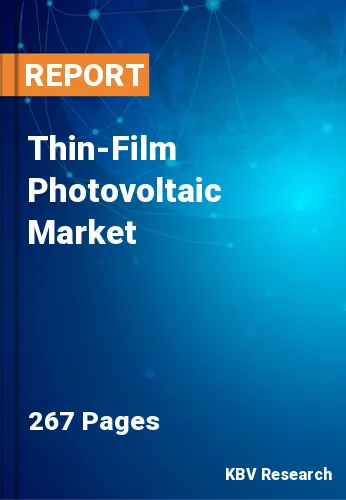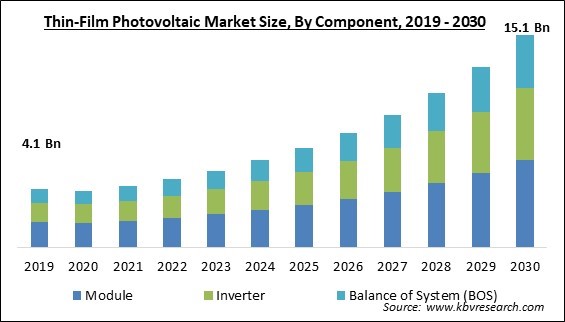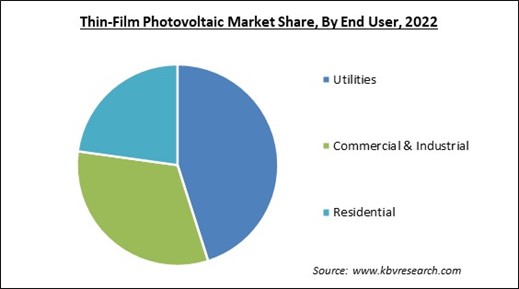
The Global Thin-Film Photovoltaic Market size is expected to reach $15.1 billion by 2030, rising at a market growth of 15.6% CAGR during the forecast period.
The beneficial characteristics of perovskite, such as high absorption coefficients, broadly tunable bandgaps, and strong electronic transport capabilities for both electrons and holes lead towards the growing usage of material. Therefore, the perovskite segment captured $521.4 million revenue of the market in 2022. The perovskites are a class of substances with a common crystal structure. The Solar Energy Technologies Office (SETO) of the US Department of Energy (DOE) aims to enable future commercialization with a $20 million will fund initiatives on industrial perovskite PV R&D. Methylammonium lead halides are the organic-inorganic hybrid perovskites most frequently utilized for photovoltaic (PV) applications. To obtain even higher efficiencies, perovskites are frequently combined with CIGS, crystalline silicon, as well as other PV technologies in tandem or multi-junction cells. Some of the factors impacting the market are inclusion of thin-film solar cells into materials used in construction, technological advancements in thin-film photovoltaic, and lack of competent labor and limited technological maturity.

Thin-film solar cells, commonly referred to as building-integrated photovoltaics (BIPV), are increasingly being incorporated into building materials. The usage of this integration is rising as a result of its many advantages. Thin-film solar cells allow for flexible design and can be easily incorporated into a variety of architectural components, such as facades, roofs, windows, and even transparent surfaces. The cost-effectiveness, efficiency, and scalability of thin-film photovoltaic systems have been greatly enhanced by ongoing technological developments. Thin-film solar cells now have a wider commercial potential because of advancements, including improved light absorption, improved conversion efficiency, and the utilization of novel materials. Traditional solar panels weigh one hundred times as much as these new ones, yet they generate 18 times the amount of power per kilogram. Therefore, the rapid advancement in thin-film technology will boost the market's growth throughout the forecast period.
However, thin-film photovoltaic technologies are more recent and less developed than conventional silicon-based solar cells. Thin-film technologies have a less established and tested history due to the short time available for research, development, and improvement. Due to this factor, potential investors and customers are now more hesitant to make large-scale investments in these technologies. Moreover, other renewable energy sources like wind and concentrated solar power (CSP) compete with thin-film photovoltaic technologies. These alternative technologies are well-established businesses, have their benefits, and provide a threat to thin-film photovoltaics in terms of market share and expansion prospects.
By end user, the thin-film photovoltaic market is divided into residential, commercial & industrial, and utilities. The utilities segment procured the maximum revenue share in the thin-film photovoltaic market in 2022. Thin-film photovoltaics have a significant demand in the utility sector. Next-generation solar cells have a tremendous possibility to meet and replace traditional solar cells because the utility sector's demand for solar cells is rising. Many governments started and sped up the deployment of different photovoltaic material-based solar panels for the utility sector.

On the basis of component, the thin-film photovoltaic market is classified into module, inverter, and balance of system (BOS). The module segment witnessed the largest revenue share in the thin-film photovoltaic market in 2022. Over the past few years, the module demand has grown dramatically due to factors such as rising government support for solar energy adoption worldwide, rising use of renewable technologies for energy generation, and PV module technological improvements. Several modules can be joined in a single string when employing thin-film modules, such as CdTe-based ones, which operate at greater voltage.
Based on material, the thin-film photovoltaic market is characterized into cadmium telluride, amorphous silicon (A-Si), perovskite, copper indium gallium selenide (CIGS), organic PV, copper zinc tin sulfide (CZTS), quantum dot thin film solar cells, and all-silicon tandem. The amorphous silicon (A-Si) segment procured a considerable growth rate in the thin-film photovoltaic market in 2022. A glass, metal, or plastic substrate with layers of non-crystalline silicon on top creates amorphous silicon (A-Si) panels. Their use of harmful materials is reduced, and they preserve flexibility, durability, and weight reduction owing to their structure. In comparison to crystalline silicon cells, A-Si solar cells need less material.
| Report Attribute | Details |
|---|---|
| Market size value in 2022 | USD 4.8 Billion |
| Market size forecast in 2030 | USD 15.1 Billion |
| Base Year | 2022 |
| Historical Period | 2019 to 2021 |
| Forecast Period | 2023 to 2030 |
| Revenue Growth Rate | CAGR of 15.6% from 2023 to 2030 |
| Number of Pages | 267 |
| Number of Table | 390 |
| Report coverage | Market Trends, Revenue Estimation and Forecast, Segmentation Analysis, Regional and Country Breakdown, Companies Strategic Developments, Company Profiling |
| Segments covered | Component, Material, End User, Region |
| Country scope | US, Canada, Mexico, Germany, UK, France, Russia, Spain, Italy, China, Japan, India, South Korea, Singapore, Malaysia, Brazil, Argentina, UAE, Saudi Arabia, South Africa, Nigeria |
| Growth Drivers |
|
| Restraints |
|
Region wise, the thin-film photovoltaic market is analyzed across North America, Europe, Asia Pacific, and LAMEA. The Asia Pacific segment recorded the highest revenue share in the thin-film photovoltaic market in 2022. The development of the market in the Asia Pacific region is largely due to India and China. In the thin-film photovoltaics market, these nations are developing quickly. The market is expanding due to beneficial government initiatives in Asia and the Pacific. Nations like China, India, and Australia have expedited their deployment of renewable energy to meet their emission requirements, which has resulted in an increase in solar energy utilization.
Free Valuable Insights: Global Thin-Film Photovoltaic Market size to reach USD 15.1 Billion by 2030
The market research report covers the analysis of key stake holders of the market. Key companies profiled in the report include Kyocera Corporation, Kaneka Corporation, Mitsubishi Electric Corporation, Sharp Corporationm, Jinko Solar Holding Co., Ltd., Panasonic Holdings Corporation, Emeren Group Ltd. (ReneSola Co. Ltd.), JA SOLAR Technology Co., Ltd., Suntech Power Holdings Co. Ltd., Yingli Solar Co., Ltd.
By Component
By Material
By End User
By Geography
This Market size is expected to reach $15.1 billion by 2030.
Incorporation Of Thin-Film Solar Cells into Materials Used in Construction are driving the Market in coming years, however, Lack Of Competent Labor and Limited Technological Maturity restraints the growth of the Market.
Kyocera Corporation, Kaneka Corporation, Mitsubishi Electric Corporation, Sharp Corporationm, Jinko Solar Holding Co., Ltd., Panasonic Holdings Corporation, Emeren Group Ltd. (ReneSola Co. Ltd.), JA SOLAR Technology Co., Ltd., Suntech Power Holdings Co. Ltd., Yingli Solar Co., Ltd.
The expected CAGR of this Market is 15.6% from 2023 to 2030.
The Cadmium Telluride segment acquired maximum revenue share in the Market by Material in 2022; thereby achieving a market value of $4.3 billion by 2030.
The Asia Pacific region dominated the Market by Region in 2022, and would continue to be a dominant market till 2030; thereby, achieving a market value of $6.2 billion by 2030.
Our team of dedicated experts can provide you with attractive expansion opportunities for your business.
